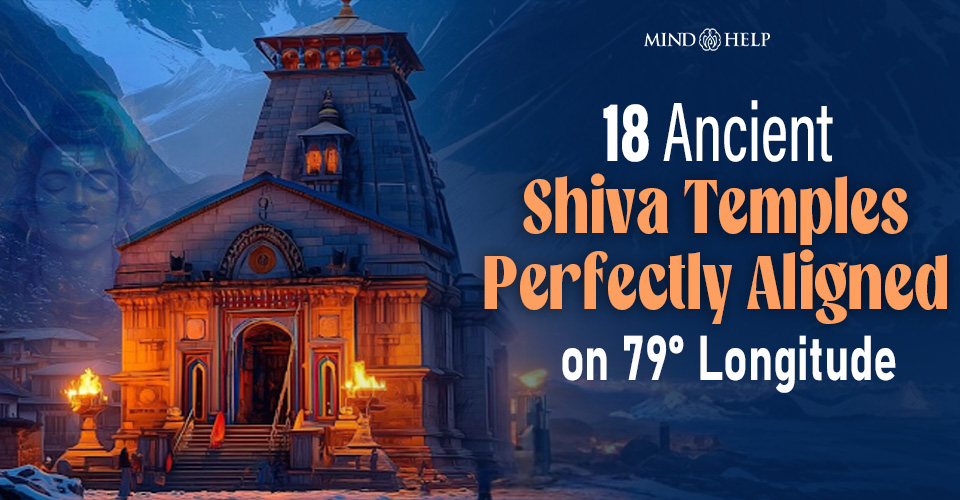The ancient Shiva temples of India are not just symbols of devotion; they are living testaments to the sacred science and geometry that once guided the land.
Hidden within the sacred geography of India lies a breathtaking mystery: 18 Shiva temples on the same longitude, aligned with uncanny precision along the 79° East meridian.
From the icy peaks of Kedarnath to the coastal sanctum of Rameswaram, these Shiva temples seem connected by more than faith, they echo a deeper harmony between earth, energy, and divinity.
This extraordinary alignment invites us to explore how ancient sages may have used the planet itself as a map for cosmic consciousness.
Related: A True Divine Connection: 7 Spiritual Signs That Lord Shiva Is With You
When Temples Spoke to the Stars
Sometimes, a number isn’t just a number.
Sometimes, it’s a language the cosmos speaks in.
That’s what the 79° East longitude feels like; a secret line running through India’s spiritual spine, where ancient Shiva temples seem to hum in the same vibration. That’s the beauty of the sacred geography of India.
Long before anyone had compasses or satellites, our sages somehow knew where energy flowed strongest. They called it Siva Sakthi Aksh Rekha – a celestial highway that connects temples, time, and transcendence.
It’s as if every temple on this line is a cosmic Wi-Fi router, transmitting Shiva’s energy across millennia.
The Sacred Geography of India: A Living Energy Map
You see, the sacred geography of India wasn’t drawn by rulers, it was sense by seers. Mountains were not just peaks, they were resting points for gods. Rivers weren’t just water, they were living energies.
And these Shiva temples on the same longitude? They were not random dots. They were part of a larger design, one that merged astrology, astronomy, and devotion into pure geometry.
Each temple along 79° E resonates with a certain tattva (element), creating a chain of energy centers that keep the subcontinent’s spiritual heartbeat alive.
It’s like the ancients were not really concerned with “where to build” and more concerned with “where the universe breathes.”

The Celestial Lineup: 18 Temples, One Energy Line
1. Kedarnath Temple (Uttarakhand)
High in the Himalayas, Kedarnath feels less like a temple and more like a pulse frozen in snow. Built where legend says the Pandavas sought forgiveness, it marks the northern crown of this cosmic line.
When the bells ring through the thin mountain air, it’s easy to believe you are standing where heaven begins – the first vibration of Shiva’s frequency.
2. Sri Kasi Viswanath Temple (Varanasi, Uttar Pradesh)
Kashi doesn’t just exist – it breathes eternity. On the banks of the Ganga, this shrine to the Lord of the Universe sits nearly on the same longitude as Kedarnath.
They say Shiva whispers liberation here; even the dying wait for that final word. It’s as if the meridian itself pauses to listen.
3. Sri Bhramaramba Mallikarjuna Swamy Temple (Srisailam, Andhra Pradesh)
Half hidden in the Nallamala hills, this temple is where Shiva and Shakti live as Mallikarjuna and Bhramaramba – stillness and motion in one place.
Standing here, the air feels charged, like the leyline beneath your feet is alive, connecting the Himalayas above and the ocean below.
4. Srikalahasti Temple (Andhra Pradesh)
Here, the wind never stops. Dedicated to Shiva as Vayu, this temple literally breathes – its lamps flicker without a draft.
Built into the same 79° E alignment, it’s a place where air becomes sacred, and every gust feels like the exhale of the universe.
5. Sri Veerabhadra Swamy Temple (Lepakshi, Andhra Pradesh)
In Lepakshi, the stones themselves seem enchanted. The famed “floating pillar” hangs defiantly off the ground, which serves as proof, some say, of divine engineering.
Veerabhadra, Shiva’s fierce warrior form, presides here, guarding the longitude’s southern stretch. The carvings whisper stories older than gravity itself.
6. Ekambareswarar Temple (Kanchipuram, Tamil Nadu)
Kanchipuram is called the city of a thousand temples, but Ekambareswarar stands like the Earth itself – solid, enduring. Dedicated to Shiva as the element of Prithvi, it anchors the longitude in the southern plains.
Beneath its ancient mango tree, you can almost feel the planet breathe.
Related: 7 Laws Of Karma By Shiva: Understanding The Divine Path To Enlightenment
7. Sri Kailasanathar Temple (Kanchipuram, Tamil Nadu)
Just nearby, this Pallava-era marvel glows with sandstone grace. Every corridor aligns with sunlight in a way that mirrors the stars. Along the 79° E line, it’s like a finely tuned note in a symphony, delicate but precise.
8. Annamalaiyar Temple (Tiruvannamalai, Tamil Nadu)
The same sacred town holds this vast temple complex, whose gopurams rise like mountains. It mirrors the hill’s flame, symbolizing spiritual illumination. The 79° E meridian seems to bend around it in reverence.
9. Jambukeswara Temple (Thiruvanaikaval, Tamil Nadu)
Here, Shiva resides as water – cool, clear, endless. A spring flows continuously inside the sanctum, even during drought. It’s said that this spot balances the fiery energy of Tiruvannamalai on the same axis, keeping the line in perfect harmony.
10. Nataraja Temple (Chidambaram, Tamil Nadu)
Among all the Shiva temples, this is the center of cosmic rhythm. Within its golden halls, Shiva dances the Ananda Tandava, the dance of creation and dissolution. The sanctum’s empty space – Chidambara Rahasya – represents ether itself.
On the 79° E line, this temple is pure vibration, the sound between beats.
11. Kaleshwara Mukteeshwara Swamy Temple (Kaleshwaram, Telangana)
At the confluence of the Godavari and Pranahita rivers, two lingams share one base – Shiva and Yama together, life and death inseparable. The temple sits eerily aligned with the rest, as though marking a threshold between worlds.
12. Sri Bhimeswara Swamy Temple (Draksharamam, Andhra Pradesh)
One of the sacred Pancharama temples, Bhimeswara’s massive lingam radiates calm power. Local lore says Shiva manifested here to dissolve arrogance – reminding that even the divine line hums with humility.
Step inside and you feel the longitude as a soft vibration underfoot.
13. Sri Someswara Swamy Temple (Somanathapuram, Tamil Nadu)
This riverside temple to Someswara – the Moon-God aspect of Shiva – glows with lunar calm. The priests say tides respond to its rituals. Perhaps coincidence, perhaps cosmic resonance. Either way, it keeps the longitude’s rhythm gentle and cool.
14. Thirukuvalai Temple (Thirukuvalai, Tamil Nadu)
A lesser-known jewel, Thirukuvalai holds deep tantric significance. Locals call it the place where the Earth’s breath slows. Small, serene, and aligned perfectly on the line, it’s a quiet exhale in the divine geography.
15. Sri Ramalingeswara Swamy Temple (Amaravati, Andhra Pradesh)
By the Krishna River, where breeze carries the scent of jasmine and clay, stands this quiet gem. Rama is believed to have installed the lingam here after Lanka, marking victory, repentance, and alignment.
When it comes to the sacred geography of India, this temple is the heart of the longitude, steady and serene.
16. Thiruvarur Temple (Thiruvarur, Tamil Nadu)
Home of Tyagaraja, the Somaskanda form of Shiva, Thiruvarur pulses with devotional music. Ancient processions and temple chariots move in rhythms said to mirror planetary cycles.
It’s a musical node along the meridian, and serves as a reminder that energy can sing.
17. Sri Arunachaleswarar Temple (Tiruvannamalai, Tamil Nadu)
Here, Shiva is fire – Agni Lingam, the flame that never dies. Every year, a colossal lamp is lit atop Arunachala hill, visible for miles. Many say it marks the energy point of the entire longitude, where the axis itself blazes into being.
18. Ramanathaswamy Temple (Rameswaram, Tamil Nadu)
At the line’s southern end, where land dissolves into ocean, stands Rameswaram – the final, shimmering note. Rama himself is said to have worshipped Shiva here before crossing to Lanka.
The temple’s endless corridors stretch like the meridian itself, a tunnel of devotion running straight through the soul of India.
Not Just Temples But Portals of Energy
What’s fascinating is how these ancient Shiva temples seem to form an energy network that defies time and tools. Even modern architects are baffled; how could builders thousands of years ago align temples so precisely across vast distances?
The answer may not be found in blueprints, but in consciousness itself. Our ancestors didn’t build temples just to worship; they built them to tune reality. Each shrine was a spiritual amplifier which are designed to connect you not just to God, but to the frequency of existence itself.
The sacred geography of India isn’t just geography. It’s a living organism, pulsing with the memory of the cosmos.
Related: The Night Of Shiva
A Civilization That Built with the Universe
Think about it – long before we spoke of “energy grids,” they had already mapped them. The Rishis and Sthapathis who designed these temples weren’t guessing; they were decoding. They saw Earth not as land, but as energy, rather a being that could be balanced, healed, and elevated through geometry and sound.
These Shiva temples on the same longitude are proof that the ancients understood something we are only rediscovering today that space, sound, and spirit are deeply connected.
From Kedarnath’s frozen silence to Rameswaram’s salty wind, the 79° line hums with an ancient song. You can’t hear it, but if you stand quietly enough… you will surely feel it.
Bottomline: The Genius of Ancient India
Call it coincidence, call it divinity, call it sacred science, but you can’t deny the mystery. Eighteen ancient Shiva temples, each perfectly placed, aligned along one invisible line across India’s body. This isn’t just architecture; it’s awareness carved into stone.
The next time someone tells you our ancestors were primitive, show them the sacred geography of India, and the Shiva temples on the same longitude. Because sometimes, genius isn’t measured in equations, it’s measured in devotion, vibration, and a line drawn straight through eternity.








